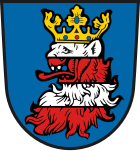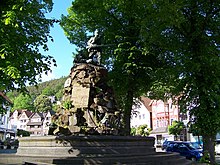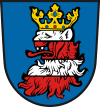Biedenkopf district
| coat of arms | Germany map | |
|---|---|---|

|
Coordinates: 50 ° 55 ' N , 8 ° 32' E |
|
| Basic data (as of 1974) | ||
| Existing period: | 1832-1974 | |
| State : | Hesse | |
| Administrative headquarters : | Biedenkopf | |
| Area : | 406.76 km 2 | |
| Residents: | 65,000 (Dec. 31, 1973) | |
| Population density : | 160 inhabitants per km 2 | |
| License plate : | BID | |
| Circle key : | 06 1 33 | |
| Circle structure: | 50 parishes | |
The district of Biedenkopf was created on June 6, 1832 by a grand ducal Hessian edict and essentially comprised the northern part of the Hessian hinterland . It emerged from the previous districts of Gladenbach , Battenberg and Vöhl . In 1974 the district was dissolved as part of the regional reform in Hesse and merged with the district of Marburg and the independent city of Marburg to form the district of Marburg-Biedenkopf .
geography
Beginning in 1974, the district bordered clockwise in the northeast to the districts of Waldeck-Frankenberg , Marburg and Wetzlar as well as the Dill district (all in Hesse) and the Wittgenstein district in North Rhine-Westphalia .
history
middle Ages
Until the 8th century there was no written evidence about the area of the district. However, many finds point to a settlement in the early La Tène period or even earlier. Since the allocation of the region in Gaue as early territorial units is very difficult, it is almost impossible to allocate it to individual counties, as these often had a large number of small districts and this was often done through buying and selling, war and conquests or simply through inheritance changed. At that time the area of the district was in the Hessengau and the Lahngau , or Oberlahngau . An exact description of the ownership structure is not possible. But from the fiefdoms of the noble family Eppstein it can be reconstructed that the archbishopric of Cologne had rights over unfree (so were feudal lords) between the rivers Perf , Dautphe and Allna in the 12th century . Shortly afterwards, these rights were passed on to the Counts of Nassau , who in turn passed the rights on to the Lords of Eppstein by the beginning of the 1190s at the latest.
Landgraviate of Hesse
After the death of the last Ludowinger, Heinrich Raspe IV , the Thuringian-Hessian War of Succession took place between 1247 and 1263 among the successors of the Landgraves of Thuringia. Heirs to the Landgraves of Hesse-Thuringia were the two daughters Gertrud and Sophie from the marriage of Landgrave Ludwig IV (1200-1227) and the Hungarian king's daughter Elisabeth (1207-1231), who was canonized in 1236 when St. Elisabeth went down in history. From 1248 Gertrud was abbess of the imperial monastery Altenberg near Wetzlar, Sophie had a son Heinrich from her marriage to Duke Heinrich II of Brabant . Sophie von Brabant took over the reign of her underage son in the Hessian region and paid homage to Marburg. With the backing of the Archbishop of Mainz, the Counts of Nassau refused to take the feudal oath ( the landgraves were entitled to feudal sovereignty over the rule of the Westerwald, Herborner Mark and Haigerer Mark). Duchess Sophie massively asserted the claims and was initially able to enforce her claims in Hesse against the archbishops of Mainz , Trier and Cologne as well as the houses of Nassau and Solms in the course of 1263 . The new Landgraviate of Hesse was confirmed by the Emperor in 1292 as a principality independent of Thuringia and on an equal footing with the duchies. Landgrave Heinrich I of Hesse (* 1244; † 1308) became the progenitor of all Hessian landgraves.
The clashes and violent feuds did not end, however, and dragged on until 1336. They became known as the "100 year old Dernbach feud " between the Counts of Nassau and the Archbishop of Mainz on the one hand and the Landgraves of Hesse and the local knighthood (including "von Dernbach" and "von Bicken") on the other. In particular, it was about the enforcement of state sovereignty in the later Blankenstein office , especially in its western part (today the municipality of Bad Endbach), in the Mark Dautphe, the later Biedenkopf office , the Breidenbacher Grund and the control of the important long-distance trade route Cologne-Leipzig (also " Brabanter Straße "), which, coming from Cologne via Siegen, moved on to Leipzig via Angelburg , Marburg and Eisenach. To secure this long-distance trade route and to enforce his claims, the Landgrave of Hesse built the castles Wallenfels , Eisemroth , Hessenwalt bei Roth and Neu-Dernbach as the outer bailey of the Blankenstein and expanded Biedenkopf . Already in the period from 1297 to 1307 Hesse had the cents Lohra and Fronhausen , as well as the "lower court" of the Blankenstein office through the 29 km long Mittelhessische Landheegen (Innenheege) ( Landwehr ) from the Allerburg near Rachelshausen to Odenhausen ad Lahn against Nassau in the west protected. After the feuds ended, the Blankenstein Higher Court (today Bad Endbach ) was secured with a further 16 km long hedge from Kreuzberg near Bottenhorn to the Zollbuche between 1359 and 1374 . The demarcation of the outer hedge at that time was formerly preserved as a state boundary and to this day as a district and community boundary.
After several inheritance divisions and associations, it was only through the death of Philip the Magnanimous that a permanent division took place. After that, the area of the district fell to Ludwig IV. In 1307 the lords of Breidenbach handed over the towns of Ditzrode , Fischelbach, Hesselbach , Niederlaasphe and Puderbach to the Counts of Wittgenstein , and in 1387 also the Richstein Castle . Since then, this constellation, north of the former Blankenstein district, has more or less represented the western border of the Biedenkopf district.
Formation of the district under Hessen-Darmstadt
In the Grand Duchy of Hesse (Hessen-Darmstadt), the districts of Battenberg, Vöhl and Gladenbach were combined to form the Biedenkopf district on June 6, 1832. The Vöhl district retained a special status and was not fully integrated into the Biedenkopf district.
The district becomes Prussian

After the March Revolution in 1848, the district became the administrative district of Biedenkopf by ordinance and included the districts of Biedenkopf, Gladenbach, Battenberg and Vöhl. Just four years later, in 1852, this was abolished and transferred to the Biedenkopf and Vöhl districts .
In the war of 1866, the Grand Duchy of Hesse-Darmstadt fought on the side of Austria against Prussia and thus on the side of the losers. According to Article 14 of the peace treaty , Hessen-Darmstadt had to go to August 3, 1866 a. a. cede the northern part of the district of Gießen with the localities Fellingshausen, Frankenbach, Hermannstein, Königsberg, Krumbach, Naunheim, Rodheim and Waldgirmes as well as the offices of Battenberg, Biedenkopf, Blankenstein, Vöhl and Itter to Prussia.
Grand Duke Ludwig IV released his previous subjects from the Hessian state association on September 17, 1866. But it was not until February 4, 1867 that the Prussian civil commissioner von Patrow officially incorporated the new district into the Kingdom of Prussia (based on the possession patent granted by the King of Prussia on January 12, 1867) . Prussia had formed a new Biedenkopf district from the former offices of Battenberg, Biedenkopf and Blankenstein . For a few months the district was given the name "Hinterlandkreis" (July 1, 1867 to August 12, 1867) due to its historical reference, until it was given its former name, Biedenkopf District, by a ministerial decree . On February 22, 1867, the Prussian province of Hesse-Nassau was formed, divided into the administrative districts of Kassel and Wiesbaden, with the provincial capital Kassel. The district came twelfth to the administrative district of Wiesbaden . After 1918 the Kingdom of Prussia became the Free State of Prussia . The district retained this structure until August 1, 1932.
Third Reich until the end of the Second World War
Due to the requirements in the savings ordinances of the Reich President , the circle was dissolved after 100 years of existence despite vehement protests on August 1, 1932:
- The northern part of the district with the communities Allendorf (Eder) , Battenberg (Eder) , Battenfeld , Berghofen , Biebighausen , Bromskirchen , Dodenau , Eifa , Frohnhausen , Hatzfeld (Eder) , Holzhausen / Eder , Laisa , Oberasphe , Reddighausen and Rennertehausen came to the district of Frankenberg in the administrative district of Kassel . This area corresponded to the former Battenberg office.
- The southern part of the district, which was also jokingly called "Pannkuchevertel", with the communities Fellingshausen , Frankenbach , Hermannstein , Königsberg , Krumbach , Naunheim , Rodheim an der Bieber and Waldgirmes came to the district of Wetzlar
- The main part of the Biedenkopf district came to the newly formed Dillenburg district .
As early as 1933, the district of Biedenkopf was re-established by law due to violent protests from the population, whereby the areas that had fallen to the districts of Frankenberg and Wetzlar and thus around 40% of the former area did not return to the district. The district now comprised 66 communities, including the cities of Biedenkopf and Gladenbach .
The name Hinterland stuck to the rest of the circle; it was therefore also called "Hinterlandkreis".
On April 1, 1944, the province of Hesse-Nassau was divided into the new provinces of Kurhessen and Nassau based on the Reich defense districts and the Gaue of the NSDAP , whereby the district was now part of the province of Nassau .
Post-war period until its dissolution in 1974
After the Second World War , the American military government assigned the district to Greater Hesse on September 19, 1945 . With the referendum on December 1, 1946 on the new Hessian constitution , Greater Hesse became the state of Hesse , to which the district belonged from then on. The province of Nassau became the administrative district of Wiesbaden again . When the Wiesbaden administrative district was dissolved in 1968, its area was assigned to the Darmstadt administrative district until the Gießen administrative district was formed in 1981 .
The Hessian territorial reform began in the Biedenkopf district with the first community mergers on February 1, 1971. Through further mergers, which also resulted in two new communities with Angelburg and Steffenberg on April 1, 1972 , the number of communities in the district decreased to June 1974 50.
On July 1, 1974, most of the Biedenkopf district was merged with the Marburg district and the independent city of Marburg ad Lahn on the occasion of the third district reform in Hesse to form the new Marburg-Biedenkopf district. As a result, Biedenkopf finally lost the status of a district town after 142 years . The communities of Bischoffen , Niederweidbach , Oberweidbach , Roßbach and Wilsbach came from the Biedenkopf district to the Wetzlar district , while the communities of Roth and Simmersbach came to the Dill district . At the same time, further incorporations took place on July 1, 1974. Ultimately, seven municipalities from the Biedenkopf district joined the new Marburg-Biedenkopf district.
Population development

politics
District and district councils
- 1832–1838: Ludwig Bötticher - district councilor
- 1838–1848: Eduard Ernst App - District Councilor
- 1848–1852: Adolf Karl Friedrich Wilhelm Trapp (councilor and chairman of the Biedenkopf administrative district)
- 1852–1859: Adolf Karl Friedrich Wilhelm Trapp - District Councilor
- 1859–1866: Ludwig Röder von Diersburg - district councilor
- 1866–1867: Wilhelm Mayer - provisional district administrator
- 1867–1871: Hugo von Strauss and Torney - provisional district administrator, then district administrator
- 1871–1872: Eduard von Viebahn - provisional district administrator
- 1872–1893: Ludwig Seyberth
- 1893–1907: Friedrich von Heimburg
- 1907-1919: Julius Daniels
- 1919–1920: Erich Müser
- 1920: Konrad Emil Zorn - provisional district administrator
- 1920–1925: Walter Breuer
- 1925–1932: Heinrich Coßmann
- 1933–1937: Alfred Karl Emil Pönisch
- 1937–1945: Karl Burghof
- 1945: Gustav Schmidt
- 1945–1946: Friedrich Reinemann
- 1946–1959: Friedrich Bachmann
- 1959–1974: Siegfried Sorge
Circle coat of arms and flag
|
Blazon : "In blue a silver, gold-crowned lion's head, which is divided four times by silver and red."
The district coat of arms was approved on October 15, 1935. With the lion motif it refers to centuries of belonging to Hesse and the head to the name of the district. |
|
On December 18, 1959, the Hessian Minister of the Interior approved the following flag for the Biedenkopf district:
Description of the flag: "Two red and white divided lanes in confused colors, covered with the coat of arms of the Biedenkopf district."
Communities
License Plate
On July 1, 1956, the district was assigned the distinctive BID when the vehicle registration number that is still valid today was introduced . It was issued until June 30, 1974. Since January 2, 2013, it has been available again in the Marburg-Biedenkopf district.
literature
- Elsa Blöcher : The hinterland, a home book . 2nd revised and supplemented new edition. Stephani, Biedenkopf 1981.
- Norbert Gebauer: Hartmut von Biedenkopf . A ministerial of the Archbishop of Cologne. In: Hinterländer Geschichtsverein (Ed.): Hinterländer Geschichtsblätter . 85th year, No. 3. Wetzlar 2006.
- Hessisches Statistisches Landesamt (Hrsg.): Historical municipality directory for Hessen . Issue 1. The population of the communities 1834 to 1967. Wiesbaden 1968.
- Karl Huth : Administrative history of the district Biedenkopf . Ed .: District Committee of the Biedenkopf District. Biedenkopf 1957, DNB 452150736 .
- Karl Huth: Economic and social history of the Biedenkopf district, 1800–1866 . Ed .: District Committee of the Biedenkopf District. Biedenkopf 1962, DNB 452150744 .
- Hans K. Schulze: The county constitution of the Carolingian period in the areas east of the Rhine . Duncker and Humblot, Berlin 1973, ISBN 3-428-02945-3 .
- Erich Landgrebe: Hessen - people and space - the district of Marburg Biedenkopf . Modern community Erich Landgrebe, Offenbach / Main 1965.
- Ulrich Lennarz: The territorial history of the Hessian hinterland . Ed .: Hessian State Office for Historical Regional Studies. Elwert, Marburg 1973, ISBN 3-7708-0491-0 .
Web links
Individual evidence
- ↑ Großh.-Hess. Reg.-Bl. 1832, p. 365, p. 564
- ↑ Schulze 1973, p. 180ff.
- ↑ Gebauer 2006, p. 169ff.
- ^ Grand Ducal Hessian Government Gazette 1832, p. 563
- ^ Grand Ducal Hessian Government Gazette 1832, p. 564
- ^ Ordinance on the division of the Grand Duchy into circles of May 12, 1852 . In: Grand Ducal Hessian Ministry of the Interior (ed.): Grand Ducal Hessian Government Gazette 1852 No. 30 . S. 224–229 ( online at the Bavarian State Library digital [PDF]).
- ^ Michael Rademacher: German administrative history from the unification of the empire in 1871 to the reunification in 1990. biedenkopf.html. (Online material for the dissertation, Osnabrück 2006).
- ↑ a b Marburg-Biedenkopf district. Historical local dictionary. In: Landesgeschichtliches Informationssystem Hessen (LAGIS).
- ^ Federal Statistical Office (ed.): Historical municipality directory for the Federal Republic of Germany. Name, border and key number changes in municipalities, counties and administrative districts from May 27, 1970 to December 31, 1982 . W. Kohlhammer, Stuttgart / Mainz 1983, ISBN 3-17-003263-1 , p. 350 f .
- ↑ Approval of a flag for the Biedenkopf district from December 18, 1959 . In: The Hessian Minister of the Interior (ed.): State Gazette for the State of Hesse. 1960 no. 1 , p. 1 , point 3 ( online at the information system of the Hessian state parliament [PDF; 2.8 MB ]).







